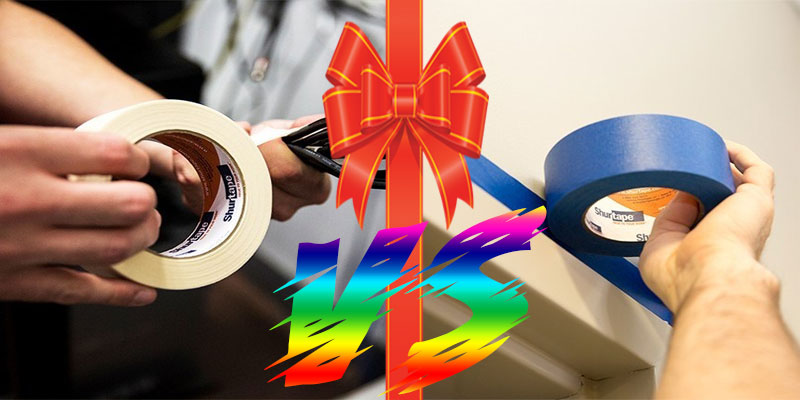Masking Tape vs Painter Tape The Ultimate Comparison

Masking Tape vs Painter Tape
Masking paint vs painter tape; which one is best for you, and when should you use them? These are important questions you should be asking if you want to get the best results from your work.
Our guide takes a look into each of these tapes. We cover what’s important to know about each of them when you should be using them, and some unique ideas, tips, and tricks.
By the end of the guide, I want you to know exactly which tape will work for you in various situations. I want you to be confident in your decision, and know what to expect in terms of real-world performance and versatility.
You’ll know how to get the best use out of your tape, and how to get the best results from your work, After reading this guide you may need the best painter’s tape.
Let’s get into the guide.
What is the Best Painter’s Tape?
To answer this question, we need to know what we’re working with. This section will take a look at masking tape is, and what painter’s tape is.
There probably isn’t an objectively rated best choice for painter’s tape. It all comes down to whether or not it meets your needs.
There’s no use in you having the best of anything if it’s of no use to you.
What’s Common between Painter’s Tape and Masking Tape?
This is a great place to start, as masking tape and painter tape are very similar. There are a couple of features that are common between the two types of tape:
- Both tapes have crepe paperbacks (the non-sticky side) for tearing by hand and writing on
- Both give you nice straight lines if that’s what you’re looking for
- All have come in similar colors and sizes – they’re quite hard to tell apart at first glance
These features can be found in both types of tape.
For the longest time, I didn’t know there was even a masking tape vs painter tape debacle until I helped my uncle repaint his living room. That’s when I learned that there are some differences, and that choosing the right tape for the job is very important.
If you want some creative and original ideas and uses for masking tape, here’s an excellent to get you started things to do with masking tape.
The Difference between Painter’s Tape and Masking Tape
There are some differences between how these tapes are made, and how they should be used. This section will highlight the main differences in the key features and functions of these tapes. We want to make sure you know exactly which tape will be best for the job you’re trying to get done.
1. Removing the Tape
- Masking tape is designed to have a stronger adhesion.
- This makes it better for general use, but also means that it’s harder to remove in one-piece.
- You’ll often find that it tears or splinters when you remove it at the end of the painting job.
- This is especially true if you’ve left the tape on for a long time.
- Masking tape also tends to leave behind some sticky residue when it’s removed.
- The amount of residue left behind depends on the surface it’s one, and how long it’s been there for.
Here Are Some Tips to Keep in Mind:
- If you’re using masking tape, remove it as soon as possible to avoid tearing and leaving behind a sticky residue
- Use painter’s tape when you’re trying to cover and protect surfaces, especially for painting
2. Adhesion (Stickiness)
- Masking tape has a stronger sticking power than painter’s tape.
- This is why it’s harder to remove and the reason that it leaves behind a sticky residue.
- Painter’s tape has a medium adhesive strength, while masking tape has high adhesive strength.
- The lower sticking strength of the painter’s tape makes it the better choice for longer-term painting projects.
- You should use masking tape when you need a stronger grip, and it’ll only be stuck for a short time.
3. Cost
- Masking tape tends to be cheaper than painter’s tape. This is because it’s a more general use, whereas the painter’s tape is far more specialized.
- There are also some types of painter’s tape that use absorbent polymers along the edges to stop paint from spilling or seeping through – these are even more expensive.
Can Masking Tape be used for Painting?
I’m sure this question has crossed your mind at some point during this guide. There are times when you’ll be home and out of painter’s tape, or you only had masking tape in the first place. You’ll need to consider the paint you’re using, and the length of time that the tape needs to be applied for.
There are two situations where you should avoid using masking tape:
- With water-based paints as they’ll cause the masking tape to wrinkle and tear
- When the tape needs to be applied for more than a couple of hours – the longer the period, the more residue that will be left behind, and the more likely the tape is to tear when it’s being removed
Other than in these two cases, you can feel free to use masking tape. It’s a cheaper and more accessible option if you don’t have painter’s tape lying around the house.
P.S. If you just want straight lines, masking tape will do the job just fine!
Is Blue Painter’s Tape Better than Masking Tape?
The blue doesn’t make much of a difference in how the tape works. Painter’s tape is still going to be the better choice for painting that using masking tape. Painter’s tape comes in two main colors:
- Tan (creamy white or beige)
- Blue (usually dark blue)
The only difference in the uses of the two colors is the types of surfaces they should be used on.
Tan-color tape should be used on grainy and gritty surfaces like concrete, bricks, etc.
Blue-color tape is usually used on wood and other painted surfaces. The adhesion isn’t as strong, making it less likely to damage the wood’s coating or pull off the layer of paint.
Other than this, blue tape is a little harder to write on. It’s harder to see black writing on a blue background.
What Can I Use Instead of Painter’s Tape?
There are a couple of alternatives to using painter’s tape. I know a lot of painters that hate using painter’s tape. It doesn’t work equally with all types of paint and can be a headache to handle at times.
Here are some alternatives if you don’t want – or don’t have access to – painter’s tape:
- Frog tape – this tape can be used on latex paints to stop the paint from bleeding and seeping though
- Angle brushes – if you learn the right techniques, with a little practice and experience, you might not even need to use tapes
- Cardboard – hold it up at the edges of the painting zone to catch dripping paint (newspaper works too)
- Edgers for painting – only use these if your walls are perfectly straight (mine aren’t)
These aren’t the only options, but they’re the easiest to get quick results from.
There are other options like painting freehand, but this takes loads of practice and experience – and there’s still a lot of room for errors.
How to Use Painter’s Tape to Make Designs
Now that we’ve got through the masking paint vs painter tape battle, here’s how you can make interesting designs with painter’s tape!
If you want to create an interesting design or pattern using a couple of different colors and some painter’s tape, then here are the steps to follow:
Step 1 – Lay the Base Color
- I prefer to use a white or creamy-white color here.
- This is the color you want in the spaces you’re going to tape over.
- After painting, let it dry for 24 hours.
Step 2 – Create Your Pattern
- Avoid curved lines as they’re very hard to do with tape.
- This step is completely up to you, and the design you want to achieve.
Step 3: Apply the Second Color
- This goes over the tape pattern. This is the color that you’ll see between the taped lines.
- Remember that it’s better to paint two lighter (thinner) layers than it is to apply one thick layer.
Step 4: Remove the Tape to Reveal the Result
- Let the paint dry for 24 hours after completing Step 3.
- Remove the tape as slowly as possible to make sure it doesn’t take any paint with it.
- This will reveal your clean and modern design!
How to Remove Paint That Leaked Under Tape?
There are products like “Oops!” and “Goof off” that can remove leaked paint.
These don’t work on all surfaces, and some paints are more resilient.
If these products fail, you can sand down the area where the paint leaked. After sanding it down, repaint it to the original color.
If you’re constantly experiencing this problem, you should try using angled and tapered brushes.
Once you get good with them, you won’t need to use tape as often.
Final Thoughts
That’s it for our guide! Well done for sticking it through. You’re well-informed and ready to choose the right tape.
You should feel confident in deciding the winner (for your needs) of the masking tape vs painter tape argument, and make the right choice to help you get the job done!




